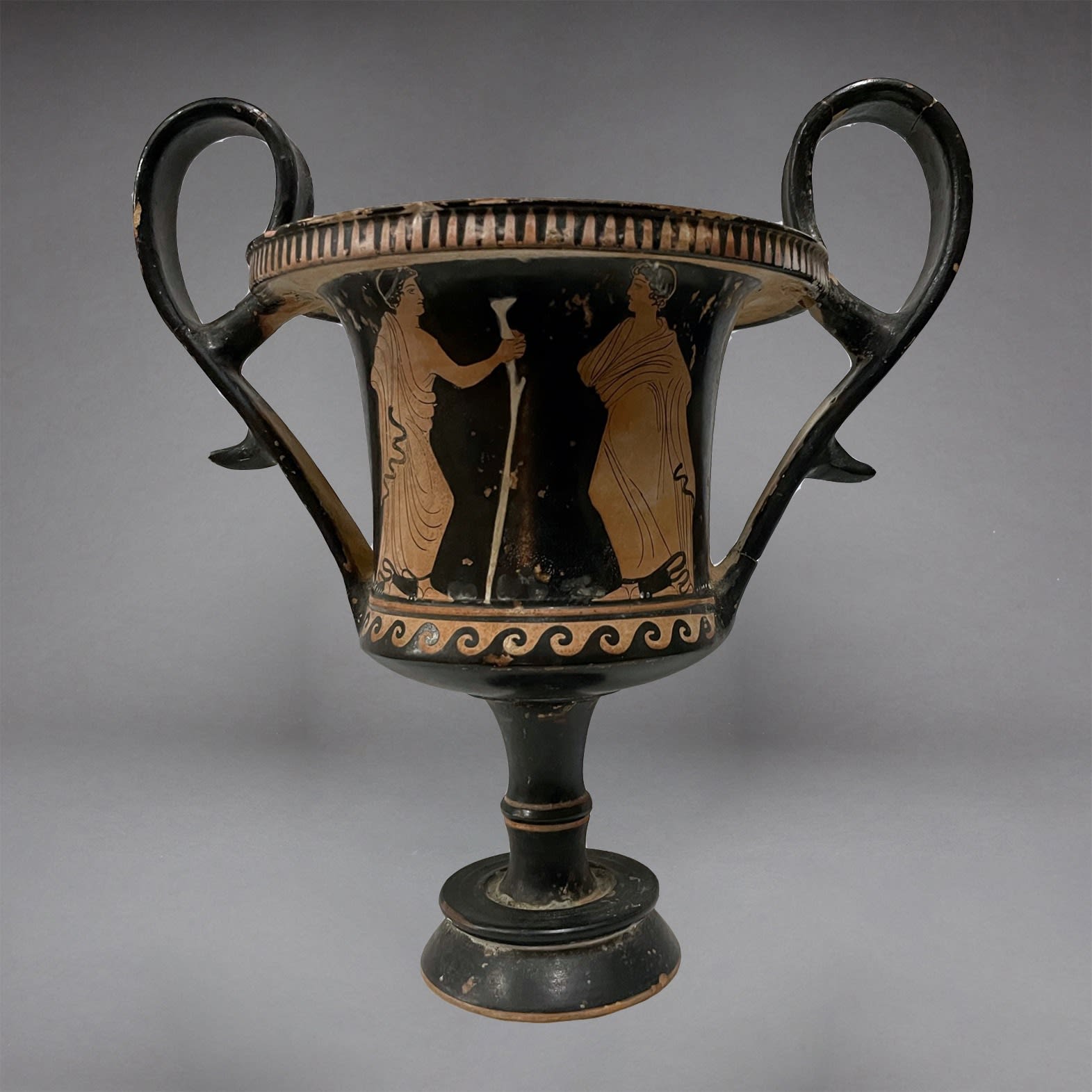Boeotian Red-Figured Kantharos, 400 BCE - 300 BCE
height 26.7 cm
height 10 1/2 in
height 10 1/2 in
LA.532
Further images
A favourite of Dionysus, the god of wine, this distinctive vessel was of great ritual and mythological importance to the central region of Boeotia on mainland Greece. With its delicate...
A favourite of Dionysus, the god of wine, this distinctive vessel was of great ritual and mythological importance to the central region of Boeotia on mainland Greece. With its delicate high-sweeping handles, deep body, and a long stem set upon a sturdy double-ringed foot, its shape is both aesthetically pleasing and functional. A certain posture of grandeur would have to be adopted in order to take a sip while holding such handles, and this is often apparent on the decoration of other vessels; a pastime of aristocratic males, drinking vessels used in the Symposium (an all male drinking party) would be decorated with scenes pertaining to the activity that was currently taking place, drinking. Decoration would often include mythological or humorous scenes to provide entertainment to the drinker, and also to provide a topic for discussion (for the Symposium was supposed to also be a platform for philosophical or political debate.) On such scenes it would most usually be a god or a hero who would be drinking from a Kantharos, while the ordinary man would drink from another vessel, the Kylix, a shallower cup set upon a long and thin stem. This gives added importance to the Kantharos, for it was the drinking vessel of the not-so-ordinary man. This is reflected in its other functions, its use as a ritual vessel for the pouring of libations to the gods as either thanks, or an invocation for help. Many have also been found in grave contexts, which is suggestive of their use of pouring libations also to the memory of the deceased.
The earliest examples of this form of drinking vessel date to around the C7/6th B.C. As the style evolved the proportions of the vessel became more elegant, as can be seen here. The handles are delicately thin and sweep out to the side of the vessel, attached to the very side of the lip, culminating in two large loops. A second option for the holding of the vessel is provided also, by the two small hooks that appear just beneath these loops. The off-set lip has a wonderfully large circumference, and is decorated with a simple geometric pattern of vertical stripes. This is echoed by the band of decoration at the vase of the body, again, a simple geometric pattern of Vitruvian scrolls, popular during this period. Beneath this is the gently curved body, its proportions slightly bigger at the base to give it an elegant appearance (and also to hold more liquid.) This also provides a large surface area for decoration. Here a mythological scene is depicted with two figures dominating the scene. On the right hand side appears a naked youth, so depicted to show off his muscular physique, suggestive of him being a hero. He hangs a cloak over his right arm and he is wearing boots on his feet, both indicative of him being engaged in some form of travels. He approaches a seated female figure, the talents of the painter of this vessel being showcased by his skills at depicting the many folds of the fabric of her dress. She is winged, and so it is likely that she is a goddess, possible Nike, the goddess of victory. She holds up her left hand to the male figure, appearing to warn him of some impending danger.
This is a beautiful example of a Kantharos, highly stylized and with intricate decoration.
The earliest examples of this form of drinking vessel date to around the C7/6th B.C. As the style evolved the proportions of the vessel became more elegant, as can be seen here. The handles are delicately thin and sweep out to the side of the vessel, attached to the very side of the lip, culminating in two large loops. A second option for the holding of the vessel is provided also, by the two small hooks that appear just beneath these loops. The off-set lip has a wonderfully large circumference, and is decorated with a simple geometric pattern of vertical stripes. This is echoed by the band of decoration at the vase of the body, again, a simple geometric pattern of Vitruvian scrolls, popular during this period. Beneath this is the gently curved body, its proportions slightly bigger at the base to give it an elegant appearance (and also to hold more liquid.) This also provides a large surface area for decoration. Here a mythological scene is depicted with two figures dominating the scene. On the right hand side appears a naked youth, so depicted to show off his muscular physique, suggestive of him being a hero. He hangs a cloak over his right arm and he is wearing boots on his feet, both indicative of him being engaged in some form of travels. He approaches a seated female figure, the talents of the painter of this vessel being showcased by his skills at depicting the many folds of the fabric of her dress. She is winged, and so it is likely that she is a goddess, possible Nike, the goddess of victory. She holds up her left hand to the male figure, appearing to warn him of some impending danger.
This is a beautiful example of a Kantharos, highly stylized and with intricate decoration.







